
Bob and Steven Dengler plan to circumnavigate the globe in this Bell Helicopter 429. Photo courtesy of Honeywell/C150GO
Can a father-son duo successfully fly a Bell Helicopter 429 Global Ranger around the globe? At this point, the answer to that question is unknown. No duo of that description has circumnavigated the world in a helicopter, or any aircraft, before (though the feat itself has been done before). But in celebration of Canada’s 150th anniversary, Bob Dengler and his son, Steven Dengler, along with retired 429 test pilot Rob “Dugal” MacDuff, are about to find out. And, thanks to Honeywell’s Aspire 200, the rest of the world can find out, too, and follow their journey in real time.
Dubbed “C150 Global Odyssey” (C150GO), the project is a registered Canadian nonprofit, raising money for True Patriot Love Foundation and Southlake Foundation. The former supports military families in Canada, including community-based programs that address challenges that veterans face. True Patriot Love also contributes to the Canadian Institute for Military and Veterans Health Research. Southlake Foundation fundraises for Southlake Regional Health Centre in Ontario. The center serves more than 1 million people.
Along with generating donations, C150GO is set to generate several “firsts.” Not only is the father-son dynamic a first, but it would also be the first Canadian helicopter global circumnavigation. Steven said the helicopter also would be the first to circumnavigate the globe with internet onboard. According to C150GO’s website, the Denglers plan to work with the FAI (Fédération Aéronautique Internationale) and Guinness World Records to make the “firsts” official. But even if no records were to become official through an organization, the circumnavigation would be recorded in another place that can cement it in history: the internet.
With Honeywell’s in-flight connectivity, the Denglers plan to be active on social media during the flight to share pictures, videos and blog posts along the way. The trip includes 103 airports in 14 countries, with several featured stops at historical sites and three onboard VIP Canadian guests that will join for various legs of the journey. The C150GO crew will have much to share. As new and exciting as that is, it’s not the only reason the crew is thankful for the Aspire 200.
“We’re going to be in constant contact with the world and chatting with fans and tweeting, but also sharing wonderful, wonderful images and videos of what we’re seeing as we go along. That being said, from a very selfish perspective, having the data in the cockpit radically increases our ability to manage mission risk in real time,” Steven told Avionics. “So we’ll get to see real-time weather; we get to be in contact with ground stations in real time.”
The plan is that in 37 days, the C150GO crew will travel some 20,000 nm. Saturday — Canada’s birthday — it is scheduled to depart National Helicopters in Vaughan, Ontario, Canada, circumnavigate the Northern Hemisphere, cross over part of the Canadian Arctic, cross over Russia and arrive back in Ontario. It’s a good thing Honeywell’s Aspire 200 Satellite Communications System has been redesigned for helicopters, using interleaver waveform that Honeywell says can deliver “error-free high-speed worldwide connectivity.”

Photo courtesy of Honeywell/C150GO
Mark Goodman, product director for satellite communication at Honeywell Aerospace (and who is also based in Canada), told Avionics that making broadband connectivity helicopter-capable presented some challenges. The main rotor hub and vibrating platform required some adjustments to the Aspire 200, which was originally designed for business/GA fixed-wing aircraft.
“As you can imagine, the challenge of connectivity and helicopter is its rotating wing up above the platform, right in between the antenna and the satellite,” Goodman said. “It was definitely a new challenge, but something that we’ve overcome with software technology.”
Throughout Honeywell’s efforts to enable connectivity on a small and lighter platform, Goodman said the product was developed to be robust, small and installable on a helicopter platform. The company has qualified Aspire 200 to be installed under aggressive vibration environments, he said. So when Honeywell had the chance to pursue supplemental type certificates for helicopters, the capability was already there.
Goodman said the first rotorcraft platform for which Aspire 200 was certified was the Leonardo AW139. The Bell 429 is the fifth. All it took was new software technology, Goodman said, that allowed the product to function efficiently under the partial blockage that occurs due to the helicopter rotors.
“A typical system will suffer from information loss as the blades swing over top and block transmission. We’ve used a technology called high data rates, or HDR, which does two things to the link,” Goodman said. “Number one, it makes the link more robust. So when there are blockages, the software uses something called a ‘long burst interleaver,’ which basically spreads the information over a longer period of time and builds error correction into the physical layer link.”
He went on to say that Honeywell introduced HDR capability for fixed-wing aircraft a couple years before. While standard speeds for SwiftBroadband are some 400 kbps, Goodman said HDR gives the user up to some 650 kbps. Aspire 200 taps into a single channel of Inmarsat SwiftBroadband, using L-band offered by the I-4 satellite constellation. Because the service is based on a 3G protocol, Goodman said it is similar to the service people may have on their smartphones. The single radio frequency (RF) channel can support simultaneous voice and data connections.
In terms of the product itself, Aspire 200 consists of the antenna, terminal, transceiver and router. The AMT-1800 antenna is a small, intermediate gain Inmarsat phased array antenna, and it typically sits on the tail boom near the cabin. Goodman describes it as being about the size of a skateboard — 18 inches in length and 2 inches in height. The antenna connects through to the Aspire 200 terminal, which contains the modems and the power stage that amplifies the signal through the antenna off and back into the aircraft from the satellite. The transceiver also includes the user interface. It takes the RF signal from a satellite, Goodman explained, and translates it into digital medium and offers it through standard interfaces, telephony or IP-based, to the user. The CNX 900 router and PBX (private branch exchange) system works like a home system does, he continued. It basically functions as the wireless access point and the smart router, he said, that aggregates and splits voice and data information out to the user devices.
“It hooks up very simply to see the satellite data unit, the Aspire 200, but then offers a very friendly user interface and standard Wi-Fi and telephony whether it’s two wire or using our voice over IP application that can sit right on your iPhone to connect the end user,” Goodman said. “In this case, it’s the Denglers and their helicopter, through to the rest of the world, over satellite.”
The application he mentioned is GoDirect Cabin Connectivity. With the app and general connectivity, Honeywell’s goal, Goodman said, is to create a normal office environment. And despite having the ability to conduct business and mitigate risks with the Aspire 200, Steven noted that there are also benefits for those who want to follow along on the journey.
“Canada’s a vast, vast country,” Steven said. “The U.S. is obviously as well. But the difference in Canada is there’s vast, vast regions of Canada that are pretty sparsely populated and that the average Canadian really can’t jump in a car and drive to and, therefore, might never see in their lifetime. Well here we are, flying a helicopter to every Canadian provincial and territorial capital from the West Coast, to the East Coast, to some of the regions in the Arctic. And we get to take pictures and video; we get to blog and share these with the world in real-time thanks to the broadband connectivity on the helicopter made possible by Honeywell. It’s really a game-changer.”